2014-11-23, 08:40
3. MPC-HC SET UP
Now that MPC-HC has been installed, the next step is to visit its many Options menus. Credit goes to the AVS Forum guide below, from which half of this information is derived. Although it should be unneeded to successfully complete set up, I would suggest the guide as a secondary reference.
AVS Forum – Advanced MPC-HC Set up Guide
http://www.avsforum.com/forum/26-home-th...guide.html
Windows Audio Set up
Before we get into the details of actual MPC-HC set up, some background work needs to be done to prepare your PC's audio configuration for surround sound playback. Windows 10 is the example operating system.
From the Windows Control Panel, select the Sound category:
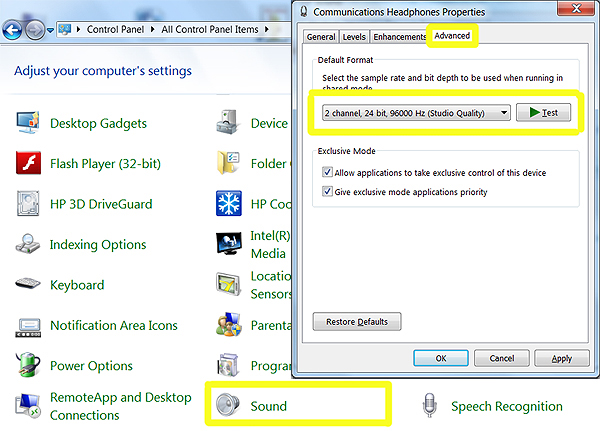
The next step is to configure your audio device to your speaker layout.
Return to the Sound category and list of devices:
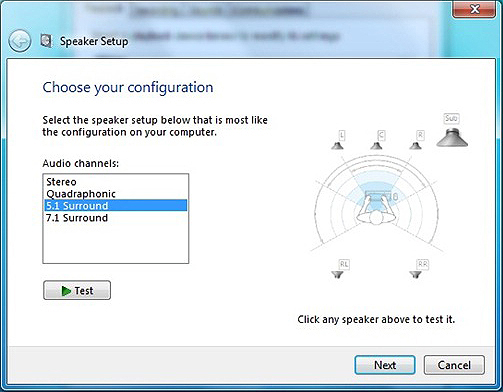
Windows Video Set up
Preparing your display for HTPC playback is a simpler process.
Right-click on the desktop and select Display settings then Advanced display settings. Your PC should be connected to your output display and report back the correct resolution.
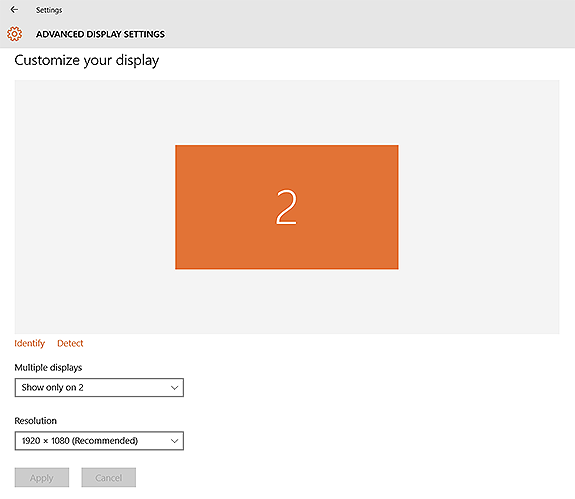
The same process should be undertaken with the display properties of your graphics card from its control panel. It is recommended to turn off all picture enhancements and set everything to be controlled by the media player.
Because madVR outputs in RGB, set the GPU to output RGB vs. Y'CbCr 4:4:4. Settings for color range (limited vs. full) and bit depth (8bpc vs. 12bpc) should align with the same settings in madVR.
MPC-HC Set up
With that background work taken care off, we will move on to MPC-HC set up. This is a section-by-section analysis of the settings that must be configured for correct player behavior within Kodi. The category listed in each section heading represents those found in the left-hand side of the Options (O) panel.
Settings Category: Player
One of the most important settings is found in the Player category. Ensure the checkbox Remember File Position is ticked, which provides a bookmark of the last known video position when MPC-HC is stopped. This function takes the place of the built-in Resume dialog in Kodi and must be checked for MPC-HC to provide proper stop and resume behavior.
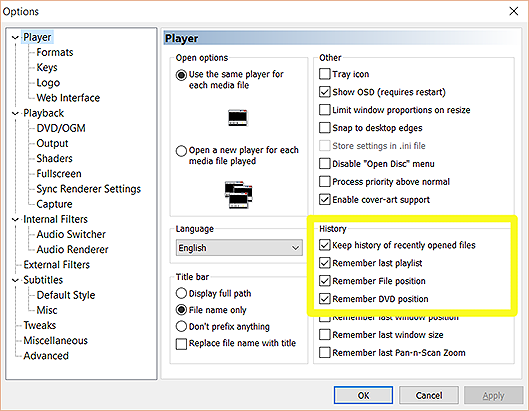
Settings Category: Fullscreen
It is advised to turn off all visible toolbars and player controls during playback (right-click -> view -> remove checkmarks). The checkbox Hide controls in fullscreen ensures elements remain hidden even if checked. The only controls that should be seen during fullscreen playback are overlays initiated by remote commands such as OSD: Display Current Time and OSD: Show File Name.
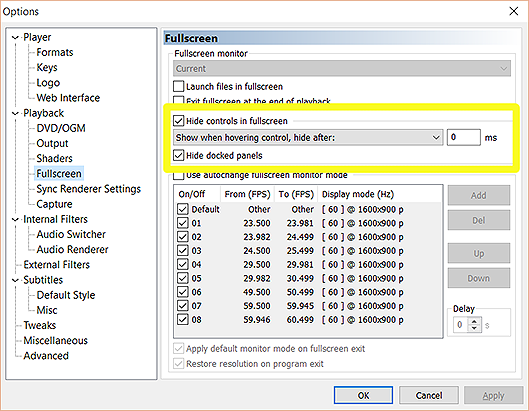
Most users will want to use madVR to handle display mode switching (where the display refresh rate is changed to match the source refresh rate). However, using the latest nightly build of MPC-HC offers the ability to add audio delays to certain refresh rates. This can be helpful with LED TVs, which often add input lag at certain frequencies such as 24p leaving the audio out-of-sync.
Adding an audio delay is as simple as checking Use autochange fullscreen monitor mode, creating an output mode and adding a delay in the Audio Delay column. You will have to disable madVR's display modes to give MPC-HC full control over refresh rate switching.
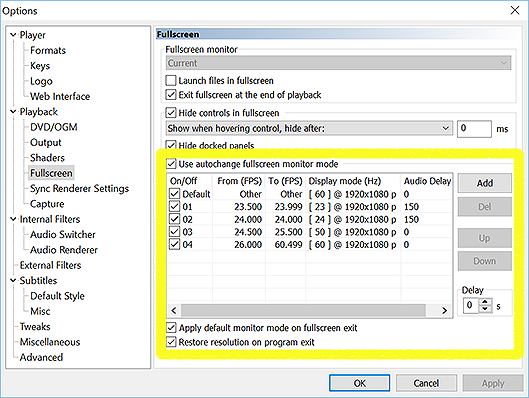
Settings Category: Output
Under Output, choose the video renderer (madVR) and audio renderer (Internal Audio Renderer). Choosing madVR, in particular, as video renderer is most important because its configuration/settings menus are only accessible when it is the active renderer. The Internal Audio Renderer offers full WASAPI support in shared or exclusive mode. A choice of subtitle renderer is also possible. Choose XySubFilter from the drop-down.
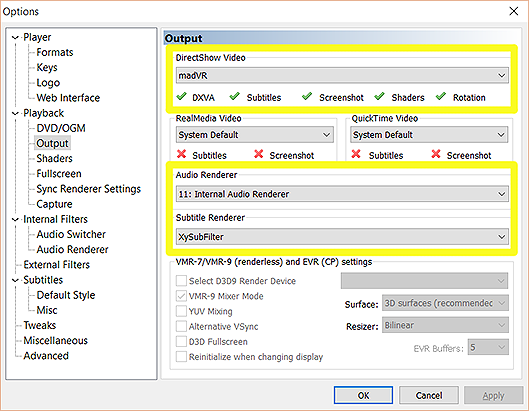
Settings Category: Audio Renderer
The Audio Renderer category is used to select the audio output mode. The MPC-HC Internal Audio Renderer relies on a backend from a project called Sanear. The benefits of Sanear include:
WASAPI exclusive mode gives applications exclusive access to the audio driver, so audio streams are passed directly to the audio output device without any interference from intermediate buffers or the Windows Mixer. Unchecking the Exclusive mode checkbox enables shared mode, where a third-party application (the Windows Mixer) is added to the playback chain forcing post-processing such as resampling and channel downmixing before reaching the output device. Under shared mode, Windows will resample PCM audio (primarily AAC, multichannel PCM and stereo sources) to the speaker layout, sample rate and bit depth set in "Sound" settings. Codecs not decoded by the media player cannot be resampled by Windows, so bitstreaming should be unaffected. Exclusive mode polls the capabilities of the audio device in terms of codec support, sample rate, bit depth and maximum channels. If the audio stream doesn't match the capabilities of the hardware, no resampling is done and audio is output as silence. Recent versions of LAV Audio include a fallback to audio decoding to PCM if the hardware device does not support the bitstream.
It is recommended to select Exclusive mode to ensure the audio output is untouched by Windows when it reaches the audio output device (e.g. AV receiver).
Time stretching and pitch correction remain a work-in-progress and have not yet been added to the renderer. In the future, these features may replace the need to use similar software such as ReClock.
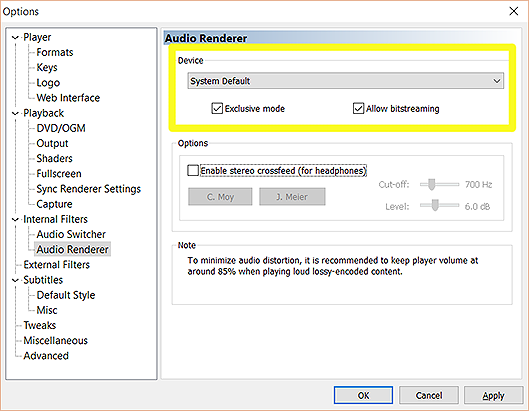
Now that MPC-HC has been installed, the next step is to visit its many Options menus. Credit goes to the AVS Forum guide below, from which half of this information is derived. Although it should be unneeded to successfully complete set up, I would suggest the guide as a secondary reference.
AVS Forum – Advanced MPC-HC Set up Guide
http://www.avsforum.com/forum/26-home-th...guide.html
Windows Audio Set up
Before we get into the details of actual MPC-HC set up, some background work needs to be done to prepare your PC's audio configuration for surround sound playback. Windows 10 is the example operating system.
From the Windows Control Panel, select the Sound category:
- Right-click on your desired audio output device.
- From the Advanced tab, choose a default sample rate and bit depth (24-bit, 96000 Hz is recommended). This is the maximum output rate and should be set to avoid downsampling when the Internal Audio Renderer is set to "shared mode."

The next step is to configure your audio device to your speaker layout.
Return to the Sound category and list of devices:
- Click on the desired output device and ensure it has the green check-mark beside it denoting it as the default audio device.
- Select Configure, and choose your matching speaker layout (5.1, 6.1, 7.1, etc.).
- Use the Test button to send out a test tone and confirm Windows recognizes all speakers.
- From here, you can further customize your set up by assigning speaker types and turning specific speakers on and off.

Windows Video Set up
Preparing your display for HTPC playback is a simpler process.
Right-click on the desktop and select Display settings then Advanced display settings. Your PC should be connected to your output display and report back the correct resolution.

The same process should be undertaken with the display properties of your graphics card from its control panel. It is recommended to turn off all picture enhancements and set everything to be controlled by the media player.
Because madVR outputs in RGB, set the GPU to output RGB vs. Y'CbCr 4:4:4. Settings for color range (limited vs. full) and bit depth (8bpc vs. 12bpc) should align with the same settings in madVR.
MPC-HC Set up
With that background work taken care off, we will move on to MPC-HC set up. This is a section-by-section analysis of the settings that must be configured for correct player behavior within Kodi. The category listed in each section heading represents those found in the left-hand side of the Options (O) panel.
Settings Category: Player
One of the most important settings is found in the Player category. Ensure the checkbox Remember File Position is ticked, which provides a bookmark of the last known video position when MPC-HC is stopped. This function takes the place of the built-in Resume dialog in Kodi and must be checked for MPC-HC to provide proper stop and resume behavior.

Settings Category: Fullscreen
It is advised to turn off all visible toolbars and player controls during playback (right-click -> view -> remove checkmarks). The checkbox Hide controls in fullscreen ensures elements remain hidden even if checked. The only controls that should be seen during fullscreen playback are overlays initiated by remote commands such as OSD: Display Current Time and OSD: Show File Name.

Most users will want to use madVR to handle display mode switching (where the display refresh rate is changed to match the source refresh rate). However, using the latest nightly build of MPC-HC offers the ability to add audio delays to certain refresh rates. This can be helpful with LED TVs, which often add input lag at certain frequencies such as 24p leaving the audio out-of-sync.
Adding an audio delay is as simple as checking Use autochange fullscreen monitor mode, creating an output mode and adding a delay in the Audio Delay column. You will have to disable madVR's display modes to give MPC-HC full control over refresh rate switching.

Settings Category: Output
Under Output, choose the video renderer (madVR) and audio renderer (Internal Audio Renderer). Choosing madVR, in particular, as video renderer is most important because its configuration/settings menus are only accessible when it is the active renderer. The Internal Audio Renderer offers full WASAPI support in shared or exclusive mode. A choice of subtitle renderer is also possible. Choose XySubFilter from the drop-down.

Settings Category: Audio Renderer
The Audio Renderer category is used to select the audio output mode. The MPC-HC Internal Audio Renderer relies on a backend from a project called Sanear. The benefits of Sanear include:
- WASAPI output in shared or exclusive mode;
- automatic channel downmixing in shared mode;
- stereo crossfeed for headphones;
- time stretching and pitch correction when playing at custom refresh rates;
- bit-exact bitstreaming support.
WASAPI exclusive mode gives applications exclusive access to the audio driver, so audio streams are passed directly to the audio output device without any interference from intermediate buffers or the Windows Mixer. Unchecking the Exclusive mode checkbox enables shared mode, where a third-party application (the Windows Mixer) is added to the playback chain forcing post-processing such as resampling and channel downmixing before reaching the output device. Under shared mode, Windows will resample PCM audio (primarily AAC, multichannel PCM and stereo sources) to the speaker layout, sample rate and bit depth set in "Sound" settings. Codecs not decoded by the media player cannot be resampled by Windows, so bitstreaming should be unaffected. Exclusive mode polls the capabilities of the audio device in terms of codec support, sample rate, bit depth and maximum channels. If the audio stream doesn't match the capabilities of the hardware, no resampling is done and audio is output as silence. Recent versions of LAV Audio include a fallback to audio decoding to PCM if the hardware device does not support the bitstream.
It is recommended to select Exclusive mode to ensure the audio output is untouched by Windows when it reaches the audio output device (e.g. AV receiver).
Time stretching and pitch correction remain a work-in-progress and have not yet been added to the renderer. In the future, these features may replace the need to use similar software such as ReClock.

